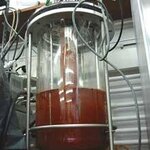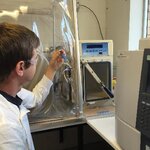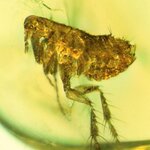Microbiology

We are often told how bad it is to keep sitting at the computer, but one good outcome at least is how some much interesting science news comes one’s way. One item dated 19 October 2015 from Radboud University (Nijmegen, the Netherlands) states:
Anammox synthesizes ‘rocket fuel’ hydrazine with special protein
Anaerobic ammonium-oxidizing (anammox) bacteria are known for their ability to convert ammonium into nitrogen gas without using oxygen. The chemical compound hydrazine, also used as rocket fuel and the strongest reductant on earth, is central in this process. An international team…

Testudinid herpesvirus 3 ( TeHV-3) is a herpes virus causing high mortality rates in several protected species of tortoises (including Hermann’s tortoise).
Until now, the 250 or so herpes viruses studied – these are found in oysters as well as in humans – are divided into six distinct genomic structures. All of them, that is, except Testudinid herpesvirus 3. Frédéric Gandar and Alain Vanderplasschen could not believe their eyes, but they had discovered a new herpesvirus genome structure. This would be the seventh. Virology reference books will need to be updated! And this does not even take…

Understanding of methane-metabolizing organisms might have to be rethought after researchers announced discovery of two new ones.
The discovery of the novel methane-metabolizing microorganisms was made using techniques that sequence DNA on a large scale and assemble these sequences into genomes using advanced computational tools.
"Traditionally, these type of methane-metabolizing organisms occur within a single cluster cluster group of microorganisms called Euryarchaeota. This makes us wonder how many other types of methane-metabolizing microorganisms are out there?" asked Gene…

Scientists engineered stem cells to better understand the mechanisms behind a form of leukemia caused by changes in a key gene.
Past work had established that inherited changes in the DNA code for the gene PTPN11 cause Noonan syndrome, a genetic disease that comes with a high risk for the blood cancer called juvenile myelomonocytic leukemia (JMML). The mechanisms behind the disease, and what influences its severity, were unknown going into the current study.
In addition, the only current treatment for JMML, a bone marrow transplant to replace the hematopoietic stem cells that become blood…

The naturally occurring bacteria on a frog's skin could be the most important tool for helping the animal fight off a deadly skin disease, according to an experiment conducted by Virginia Tech researchers.
Antibiotics to get rid of the normal bacteria don't significantly alter the rate of fungal infection, but they did cause the frogs to lose weight, suggesting that having their normal bacteria is important for frog health. In addition, treatment with probiotic bacteria did not decrease fungal infection as expected.
However, naturally occurring skin bacteria can respond to infection and…

Humans have been breeding crops until they're bigger and more nutritious since the early days of agriculture, but genetic manipulation isn't the only way to give plants a boost. In a review paper, two integrative biologists present how it is possible to engineer the plant soil microbiome to improve plant growth, even if the plants are genetically identical and cannot evolve.
These artificially selected microbiomes, which can also be selected in animals, can then be passed on from parents to offspring.
Only a few published studies have looked at the effects of artificially selecting…

A new analysis leads the authors to advance the belief that viruses are living entities that share a long evolutionary history with cells, based on a method for tracing viral evolution back to a time when neither viruses nor cells existed in the forms recognized today.
Until now, viruses have been difficult to classify, said University of Illinois crop sciences and Carl R. Woese Institute for Genomic Biology professor Gustavo Caetano-Anollés, who led the new analysis with graduate student Arshan Nasir. In its latest report, the International Committee on the Taxonomy of Viruses recognized…

Scientists successfully defeated a dangerous intestinal pathogen, Clostridium difficile, with a drug targeting its toxins rather than its life.
C. difficile is responsible for more than 250,000 hospitalizations and 15,000 deaths per year in the United States, costing the country more than $4 billion in health-care expenses, said the study's senior author, Matthew Bogyo, PhD, professor of pathology and of microbiology and immunology at Stanford University School of Medicine. Lead authorship of the study is shared by Kristina Bender, PhD, a former postdoctoral scholar in Bogyo's lab, and Megan…

About 20 million years ago a single flea became entombed in amber with tiny bacteria attached to it, providing what researchers believe may be the oldest evidence on Earth of a dreaded and historic killer - an ancient strain of the bubonic plague.
If indeed the fossil bacteria are related to plague bacteria, Yersinia pestis, the discovery would show that this scourge, which killed more than half the population of Europe in the 14th century, actually had been around for millions of years before that, traveled around much of the world, and predates the human race.
Findings on this…

People fed β-glucan-enriched pasta for two months showed increased populations of beneficial bacteria in their intestinal tracts, and reduced populations of non-beneficial bacteria. They also showed reduced LDL (bad) cholesterol. This work is part of a broad effort to identify potential prebiotics--foods that could encourage the growth of health-promoting bacteria in the gastrointestinal tract.
β-glucans are healthy fibers that humans cannot digest, but that can be digested by some species of our gut bacteria. They are special types of sugars that are found in the cell walls of certain…